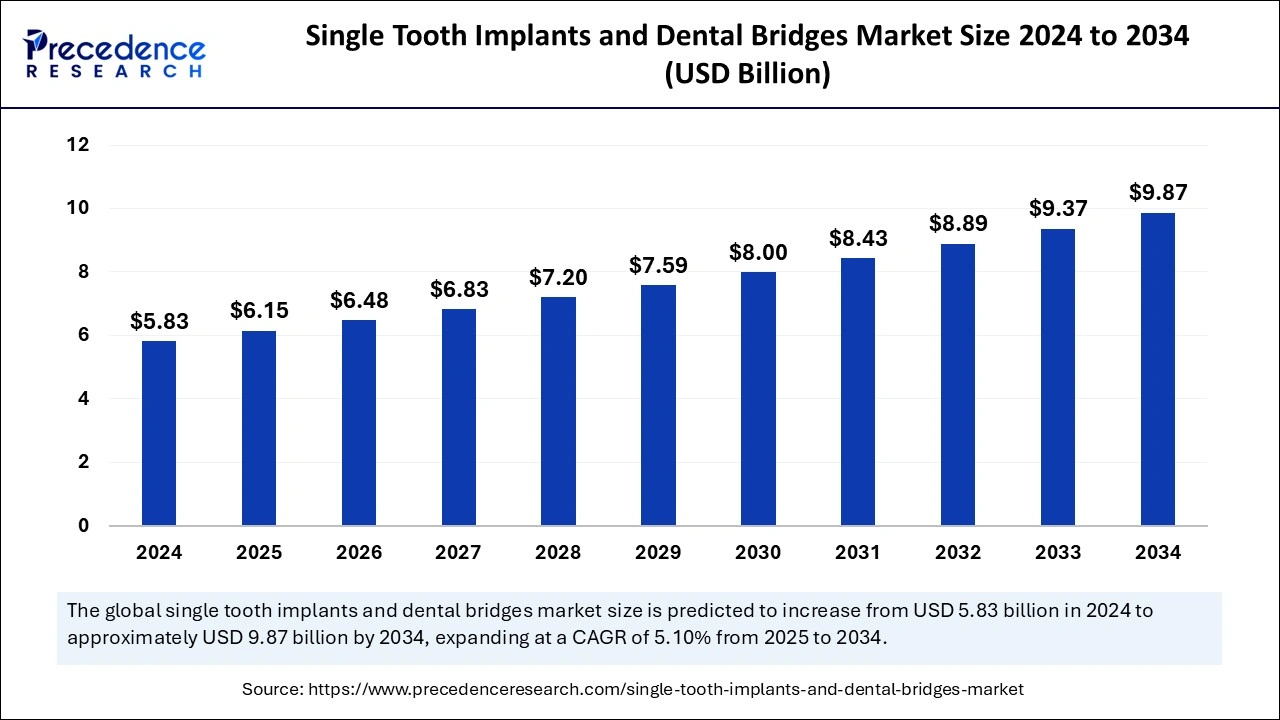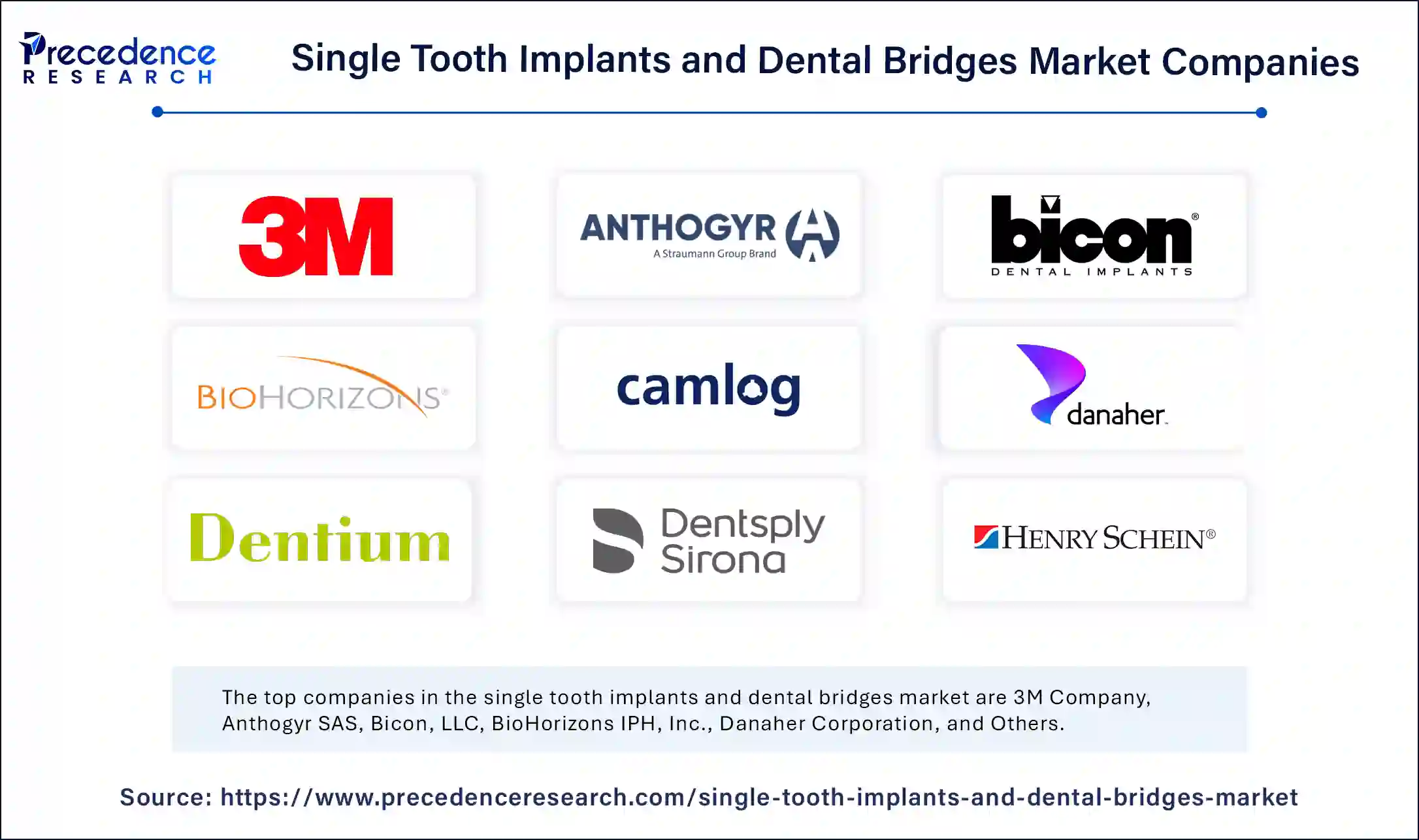January 2025
The global single tooth implants and dental bridges market size is accounted at USD 6.15 billion in 2025 and is forecasted to hit around USD 9.87 billion by 2034, representing a CAGR of 5.10% from 2025 to 2034. The market sizing and forecasts are revenue-based (USD Million/Billion), with 2024 as the base year.
The global single tooth implants and dental bridges market size was calculated at USD 5.83 billion in 2024 and is predicted to reach around USD 9.87 billion by 2034, expanding at a CAGR of 5.10% from 2025 to 2034. The rising demand for single-tooth implants and dental bridges is attributed to the growing need to replace missing teeth and help maintain oral health, including teeth and gyms.

The integration of artificial intelligence into the single tooth implants and dental bridges market is transforming the dental industry by increasing the effacing of processes such as fabricating and evaluating dental crowns with the help of AI-based software. The application of AI is commonly observed for diagnostic tasks, catering for radiographs, assessing endodontic cases, and classifying dental implant systems. The majority of artificial intelligence consists of machine learning for training models to recognize statistical patterns within datasets to perform predictions. Deep learning is used as a multi-layered neural network with intricate architecture.
A single-tooth dental implant serves as a replacement for a missing tooth, providing both the visible crown and the root structure. In the United States, approximately 120 million people are missing at least one tooth, and over 36 million individuals are completely edentulous, meaning they have lost all of their teeth. A dental implant consists of a titanium cylindrical screw that is surgically inserted into the jawbone to replace the lost tooth. Many patients find that dental bridges and dentures can be uncomfortable, making implants a preferred option.
| Report Coverage | Details |
| Market Size by 2034 | USD 9.87 Billion |
| Market Size in 2025 | USD 6.15 Billion |
| Market Size by 2024 | USD 5.83 Billion |
| Market Growth Rate from 2025 to 2034 | CAGR of 5.10% |
| Leading Region | North America |
| Fastest Growing Market | Asia Pacific |
| Base Year | 2024 |
| Forecast Period | 2025 to 2034 |
| Segments Covered | Product Type, Material, End-User, and Regions |
| Regions Covered | North America, Europe, Asia-Pacific, Latin America and Middle East & Africa |
Regenerative Dentistry
Dentists are using tissue engineering to repair and restore dental tissue and organs. This novel technique is a combination of cellular biology, material science, and tissue engineering. The overall success results in improving the structure and function of the oral tissues. Regenerative dentistry is a rapidly evolving field due to its ability to resolve the complexity of dental tissues and the need to meet the growing treatment demands.
It is commonly applicable to tooth defects such as dental caries and dental pulp regeneration, replacing whole teeth lost due to injury or disease, repairing large craniomaxillofacial defects, and treating temporomandibular joint osteoarthritis. Regenerative dentistry comprises bone grafting, which involves transplanting bone tissue to stimulate new bone growth in the deficient area; growth factors therapies, which harness the body’s natural healing mechanisms to promote tissue regeneration and guided bone regeneration; The single tooth implants and dental bridges market also involves using barrier membrane to protect and promote bone growth in the area with insufficient bone volume.
Implant failure
When an implant is placed on the lower set of teeth, there is a possible risk of nerve injury within the jawbone. Initially, it causes a numbness or a tingling sensation, but these issues can be temporary until the nerves are healed. However, in some cases, this problem could be permanent. The dentists take precautions by analyzing the nerve injury with the help of a computed tomography scan or X-rays. Moreover, there is also a risk of developing sinus problems when the dental implant is replaced on the upper jawbone, protruding into one of the sinus cavities.
It is essential to take care of the dental implant. If the bite is not adequately adjusted, infections can develop. People who have a habit of clenching or grinding teeth or putting any sort of pressure on the implant can also cause bone loss and break the implant. Maintaining proper oral hygiene is also crucial for procedures provided by the single tooth implants and dental bridges market.
In January 2025, a Woodbury dentist was suspended by the Minnesota Court of Appeal due to incompetence after putting two patients through elaborate implant surgeries that failed, leading to painful infections. The Board of Dentistry states that the failure rate of Dr. Marko Kamel is nearly 60% compared to the industry’s average failure rate of 1%-2%.
3D bioprinting technology
3D bioprinting is an advanced technology of integrated additive manufacturing with bio-inks comprising living cells and biomaterials, which creates customized tissue constructs. This is crucial for regenerating damaged tissues and restoring various maxillofacial abnormalities in the single tooth implants and dental bridges market. This technique has gained increasing interest due to its ability to precisely control the deposition of cells and material, proving a new opportunity in the dentistry field.
3D bioprinting creates scaffolds with uniform cell dispersion, which allows for customization to the desired dimension and configuration of a particular tissue. In dentistry, 3D printing includes drug delivery systems, socket preservation, root coverage, and maxillofacial prosthodontics. It is expected to expand with 4D bioprinting, introducing smart scaffolds that respond to stimuli, potentially revolutionizing tissue engineering.
The single tooth implant segment held the largest single tooth implants and dental bridges market share in 2024. The dominance of this segment is observed as dental implants last longer than dental bridges, preserve existing bones, and reduce the risk of future loss. Replacing these missing teeth with artificial teeth makes them look like real ones. Dental implants are highly preferred and adaptable because the titanium implant fuses with the jawbones, which does not cause any discrepancy, and the metal material cannot be decayed. Additionally, this act of looking presentable and being able to comfortably chew and talk provides a significant improvement to the quality of life and the health of the person, along with gaining confidence as an individual.
The dental bridges segment is expected to grow at the fastest CAGR over the projected perio. Dental bridges offer a natural-looking solution replacement for the lost tooth, which contributes to the growth of the segment. Dental bridges have the potential to restore chewing function and offer a normal way of speech. Additionally, it prevents the neighboring teeth from shifting further into the empty fap left behind by the missing teeth. However, this segment is still growing, as if a decay of trauma is caused by the artificial tooth, which can weaken the dental bridges.
The titanium segment held the largest market share of the single tooth implants and dental bridges market in 2024. Titanium has remarkable properties and success in restoring the function and aesthetics of oral health. A medial material design from titanium has the ability to encourage osseointegration, a process where the bone tissue fuses with the titanium, creating a strong and stable bond that acts as the tooth root. Titanium offers impressive properties such as strength, biocompatibility, and resistance, ensuring the implant can withstand chewing and biting and providing a long-term solution.
The zirconium segment is estimated to grow rapidly during the forecast period. There is a gradually growing interest in zirconium due to its Hypoallergenic, corrosion-resistant, and replication of bone properties. It is a bioinert, which means it will never trigger a chemical reaction, migrate to other sites in the body, or corrode. Zirconium is a new and existing technology; its only drawback is the high cost. It costs more than a titanium implant, which not everyone can afford.
The dental clinics segment led the global single tooth implants and dental bridges market in 2024. The dental care segment is dominated by getting a dental implant at a dental care clinic, educating the patient regarding the ongoing procedure, and about how to prevent disease. Getting operated under specialty practice offers a fully equipped dental staff, including dental specialists, dental assistants, and dental hygienists. The number of dental clinics has increased, and the number is expected to expand more in the coming years. In India, there are around 65,00 dental clinics and 318 government-run dental facilities in 2024. Clinics offer welcoming and comfortable patient care. The presence of trained staff ensures exceptional patient service and satisfaction.
The hospital segment is anticipated to grow at a remarkable CAGR during the forecast period. The demand for hospitals is increasing due to getting dental implant procedures in hospitals that offer completely equipped and sterilized environments. A hospital offers specialized care, sedation options, and coordination with other medical specialties in care of need. Whether it be a complex dental case, underlying condition, or emergency, it can be entirely treated.
North America dominated the global single tooth implants and dental bridges market with the largest share in 2024. The dominance of this region of experience is due to the high prevalence of dental diseases, awareness of dental treatment, and advanced healthcare infrastructure. At present, 90% of adults in America at the age of 20 to 64 years are experiencing tooth decay and gum disease, and 50% of adults at the age of 45 to 64 years have oral disease.
North America is making an effort to spread awareness among the citizens of America and improve access to dental care, reducing dental anxiety and promoting oral health habits. The high price of dental care charged by dentists in the United States contributes to the adoption of dental insurance coverage, specialized training programs, and operation expenses in dental practices.
Asia Pacific is projected to expand at a notable CAGR in the single tooth implants and dental bridges market during the forecast period. Asia Pacific is at the growing stage due to increasing healthcare facilities, rising disposable incomes, and increasing awareness regarding oral health. When it comes to dental care facilities, Thailand offers a wide range of dental services; it is known for its world-class and affordable dental facilities.
The facilitation of disposable income encourages the population to increase their spending on dental care, which is driving the Asia Pacific single tooth implants and dental bridges market. Consumers are more willing to spend money on premium quality oral care products, restoration, and aesthetic dentistry to address their desired needs. The government and companies are taking the initiative towards improving children’s dental health through awareness campaigns in schools and private events.

By Product Type
By Material
By End-User
By Geography
For inquiries regarding discounts, bulk purchases, or customization requests, please contact us at sales@precedenceresearch.com
No cookie-cutter, only authentic analysis – take the 1st step to become a Precedence Research client
January 2025
January 2025
December 2024
December 2024